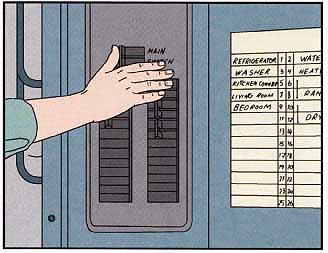Home is second only to the automobile as a dangerous place to be: Falls, poisonings, and other household accidents kill thousands of Americans and injure mil lions each year. Yet homeowners can prevent most mishaps by taking common- sense measures. Modest effort makes life easier for elderly or handicapped family members and keeps toddlers from tumbling down stairs or into a swimming pool.
Coping with Everyday Hazards -- article index:
Shutting Down the Basic Services
- Electricity
- Gas and Water
A Plan for Lowering Radon Levels
Fences to Secure a Yard
- Putting Up a Post-and-Rail Fence
- Fences for Steep Slopes
How to Make Stairs Safer
- Steadying a Loose Newel Post
- Adding a Handrail to a Stairway Wall
- Protecting Toddlers with a Safety Gate
Childproofing Storage Areas
- A Recessed Drawer Lock
Adapting a Home for the Handicapped
- Grab Bars for Shower and Bath
- A Ramp for a Wheelchair
Essential Pool Safety
Shutting Down the Basic Services
Should an electric, gas, or water emergency arise, you may need to respond quickly. Take time now to familiarize yourself with the utilities of your home, knowing where and how to shut off the electricity (below) and the main gas and water supplies . Label all circuit breakers with the outlets and fixtures they serve, and tag the gas and water shutoff valves for easy identification.
If you are ever in doubt about your ability to handle a household emergency, don't hesitate to seek technical help before one occurs. The local gas, electricity, and water companies will answer any questions you may have.
Electricity
• Locate the main circuit breaker, typically a linked, double breaker of a breaker-type service panel installed above the other circuit breakers.
• Flip the main circuit breaker to OFF to interrupt power to the entire house.
• To restore electricity, flip the main circuit breaker to ON.
Individual circuit breakers are turned off and on in the same way. To map the circuits in your house or to check the accuracy of circuit-breaker labeling, switch breakers off one at a time, noting where power is lost.
CAUTION: If the area around the service panel is damp, stand on a dry board and wear rubber gloves and rubber boots. Use only one hand, and avoid touching any metal.

Resetting a tripped circuit breaker.
• Allow the circuit breaker a minute or two to cool.
• Examine the device. If the switch has moved all the way to OFF , simply return it to ON. To reset a breaker that trips to a middle position (inset, top), push the toggle first to OFF (inset, center), then to ON (inset, bottom).
• If the breaker snaps off immediately after it's reset, disconnect one or two appliances and try again. If the breaker does not stay on, have an electrician inspect the panel.
Gas and Water

Turning off the main gas supply.
• Locate the main shutoff valve on the main gas supply pipe for the house. Usually it's found where the pipe enters the gas meter.
• Close the valve using pliers or an adjustable wrench, turning the handle perpendicular to the supply pipe .
• To restore the gas supply, open the valve by turning the handle so that it's parallel to the supply pipe.
• Relight the pilot of each appliance following the manufacturer’s instructions.

Tagging the water shutoff valve. Find the main shutoff valve
on the main water supply pipe. The valve is usually located indoors, often near
the water meter. If you draw water from a well, look for the main shutoff valve
near the pressure gauge or water pump. To help others find the valve in an
emergency, tie a label, inscribed with indelible ink, onto the valve handle
(above).
Previous: Ladders
to Escape a House Fire
Next: A Plan for
Lowering Radon Levels
